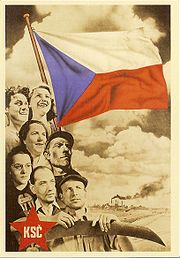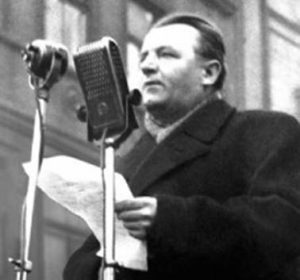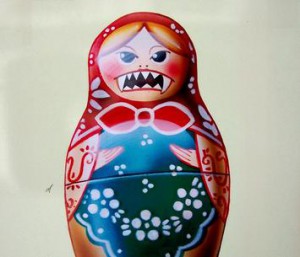The Communist Coup in Czechoslovakia
By Tracy A. Burns
On February 25, 1948, Czechoslovakia, until then the last democracy in Eastern Europe, became a Communist country, triggering more than 40 long years of totalitarian rule. In effect, the Czechoslovak Communists did not take control. They were given control. How did it happen? To come up with some answers, it is necessary to take into consideration the historical situation as far back as 1945.
After World War II through May 1946
After World War II, Czechoslovakia looked favorably on the Russians, who had liberated them. In fact, the Communist Party had had a solid following in the country from the 1920s, when the nation was democratic. Eduard Beneš, who became the postwar president, had signed a friendship treaty with the Soviets while working with the government-in-exile in 1943. The Czechoslovak army and local government structure were modeled after those in the USSR. By the beginning of 1946, there was no USSR military presence in the country, yet Communists were well-represented in the government with Klement Gottwald as the Prime Minister and other Communists looking after the ministries of the interior, agriculture, information, defense, and education. The results of the May 1946 elections demonstrated the popularity of the Party, as it nabbed 38 percent of the vote.
The Communist Party’s popularity drops
 From May 1946 until July 1947, things seemed to be running smoothly in Czechoslovakia. Then the nation wanted to obtain Marshall Aid. However, the USSR intervened and forbid their ally from accepting US help, stating that it would breach the existing friendship treaty. The Soviet Union’s decision regarding Marshall Aid did not put the Communists in favor of the people. Economic difficulties, farmers’ objections to collectivization, and disappointment with the fast pace of industrialization were additional reasons why citizens then began to see the Communist Party in a different light. Communists reacted strongly to the criticism. In November of 1947, several non-Communist ministers received parcel bombs, most likely courtesy of the Communists. A public opinion poll in January of 1948 showed that the Communists’ popularity had dropped to 25 percent and that they did not have much student support.
From May 1946 until July 1947, things seemed to be running smoothly in Czechoslovakia. Then the nation wanted to obtain Marshall Aid. However, the USSR intervened and forbid their ally from accepting US help, stating that it would breach the existing friendship treaty. The Soviet Union’s decision regarding Marshall Aid did not put the Communists in favor of the people. Economic difficulties, farmers’ objections to collectivization, and disappointment with the fast pace of industrialization were additional reasons why citizens then began to see the Communist Party in a different light. Communists reacted strongly to the criticism. In November of 1947, several non-Communist ministers received parcel bombs, most likely courtesy of the Communists. A public opinion poll in January of 1948 showed that the Communists’ popularity had dropped to 25 percent and that they did not have much student support.
Slovakia is the target and abuse of the police organ
Slovakia became the main target for the Communist Party’s attacks, as the hardliners tried to convince citizens that the Slovak Democratic Party and the Hlinka Guards of the Nazi era were connected. Communists claimed that during the Nazi regime supporters of independent Slovakia had conspired against the nation. Citing high treason, the Communists arrested 380 Slovaks, mostly those enrolled in the Democratic Party. The Communist-ridden police claimed they had discovered an espionage scheme carried out by American military attachés in Prague. The Ministry of the Interior put non-Communist politicians under close surveillance. Democratic personalities were arrested for no apparent reason. Minister of the Interior Václav Nosek fired eight non-Communist commanders in the police and replaced them with Communists. The democratic ministers were fed up with the Communists’ abuse of the police organ and security forces. They demanded that the non-Communist commanders be reinstated and that the Party cease its political attacks.
The turning point, the resignations, and the riots
 Then came a key moment. Minister of the Interior Nosek and Prime Minister Gottwald refused to give in to the demands. Trade unions showed their support for the Communist Party, and the Communists set up armed “action committees” in industrial plants, farms, and villages. The people’s militia, comprised of 7,000 members, was formed on February 20. The 12 non-Communist ministers turned in their resignations, predicting that President Beneš would be able to form a new government that would say good riddance to the Communist Party. However, that was not to be the case. Instead, violent Communist-led demonstrations erupted. Armed trade unionists rioted in the Prague streets, attacking the offices of the political opposition. The Army was the only force that could oppose the Communists, and it was run by Communist General Ludvík Svoboda. Soviet Deputy Foreign Minister Valerian Zorin, who was visiting Prague supposedly to oversee Soviet grain shipments to the country, assured the Czechoslovak army that the Russians would stop any Western interference if it arose. Then the Red Army took up positions on the Czechoslovak borders.
Then came a key moment. Minister of the Interior Nosek and Prime Minister Gottwald refused to give in to the demands. Trade unions showed their support for the Communist Party, and the Communists set up armed “action committees” in industrial plants, farms, and villages. The people’s militia, comprised of 7,000 members, was formed on February 20. The 12 non-Communist ministers turned in their resignations, predicting that President Beneš would be able to form a new government that would say good riddance to the Communist Party. However, that was not to be the case. Instead, violent Communist-led demonstrations erupted. Armed trade unionists rioted in the Prague streets, attacking the offices of the political opposition. The Army was the only force that could oppose the Communists, and it was run by Communist General Ludvík Svoboda. Soviet Deputy Foreign Minister Valerian Zorin, who was visiting Prague supposedly to oversee Soviet grain shipments to the country, assured the Czechoslovak army that the Russians would stop any Western interference if it arose. Then the Red Army took up positions on the Czechoslovak borders.
President Beneš’ dilemma
To say that President Beneš found himself in a difficult situation is a gross understatement. He was afraid the Soviets would intervene or that a civil war would start. Beneš made a big mistake by hesitating and not trying to convince the non-Communists to take action. Only some students had openly stood up to the Communists and had been physically beaten on Prague’s Nerudova Street. Besides, Beneš wanted the USSR to be a significant role-player in Eastern Europe because he did not want Germany to gain power again. He also was convinced that USSR-style Communism would be moderate, by no means extreme. Then Gottwald threatened that there would be a general strike and also presented Beneš with a list of so-called reactionaries who would be punished if he did not sign the Communist government’s set of proposals. President Beneš accepted Gottwald’s proposal for a new government that gave power to the political party which would cause so much suffering and pain and destroys so many lives for more than 40 years.
The aftermath
 The aftermath of the coup was telling. Only days later, democratic Minister of Foreign Affairs Jan Masaryk, the son of first Czechoslovak president Tomáš G. Masaryk, died a mysterious death. He either fell or was pushed off a balcony of the Czernin Palace and was found on the pavement below his office. A constitution modeled after that in the USSR became law, and Beneš refused to sign it. No opposition to the Communist Party was allowed. Many citizens were fired or arrested. A frail and sick Beneš resigned on June 6. Gottwald became President while Antonín Zapotocký took up the post of Prime Minister. Beneš passed away on September 3, 1948, and with him the democratic hopes, dreams, and tradition of Czechoslovakia died as well, only to be miraculously resuscitated in November of 1989.
The aftermath of the coup was telling. Only days later, democratic Minister of Foreign Affairs Jan Masaryk, the son of first Czechoslovak president Tomáš G. Masaryk, died a mysterious death. He either fell or was pushed off a balcony of the Czernin Palace and was found on the pavement below his office. A constitution modeled after that in the USSR became law, and Beneš refused to sign it. No opposition to the Communist Party was allowed. Many citizens were fired or arrested. A frail and sick Beneš resigned on June 6. Gottwald became President while Antonín Zapotocký took up the post of Prime Minister. Beneš passed away on September 3, 1948, and with him the democratic hopes, dreams, and tradition of Czechoslovakia died as well, only to be miraculously resuscitated in November of 1989.
Museum of Communism in Prague
The museum focuses on the totalitarian regime from the February coup in 1948 to its rapid collapse in November 1989. The theme of the Museum is “Communism- the Dream, the Reality, and the Nightmare” and visitors will be treated to a fully immersive experience. Immersive factories, a historical schoolroom, an Interrogation Room, or the video clips in our Television Time Machine are all part of the experience. The museum is a great introduction before you step back even further in time and experience the wonders of The Golden City. See the website of the Museum of Communism.




